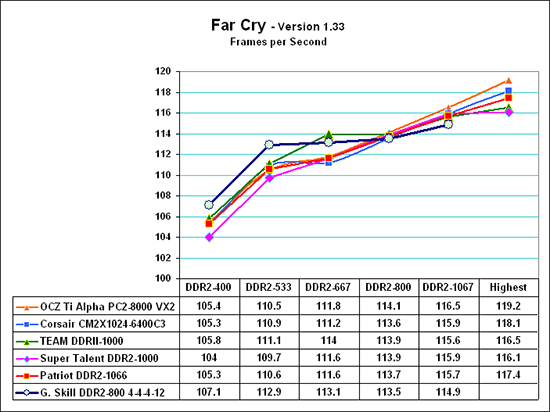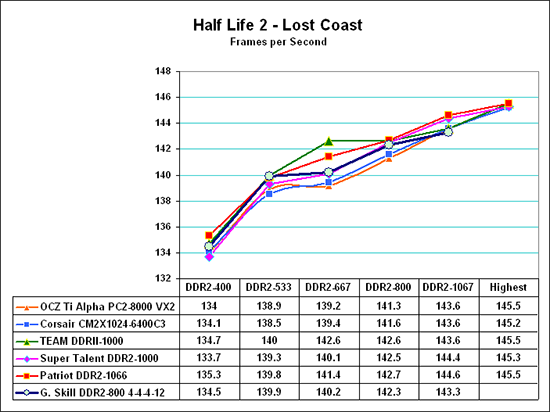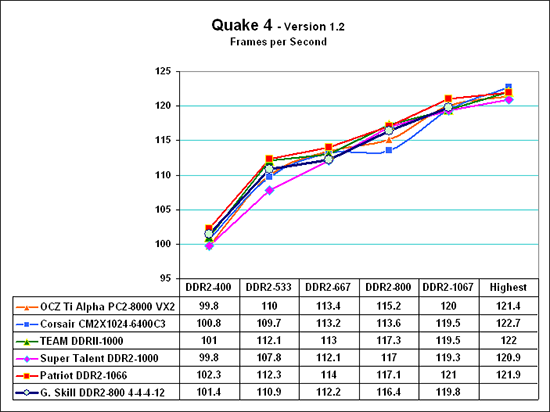Game Performance Comparison
Real-world benchmarks - specifically gaming benchmarks - provide the most useful measure of memory performance if you keep in mind what they represent. Memory is just one small part of overall gaming performance, and the AnandTech benchmarks keep everything the same except memory speed. Even the CPU speed is kept constant (except for the overclocking test). As a result performance improvements in FPS are very small because the only factor influencing the test results is memory speed. Many factors affect system performance, and memory speed is just one of those factors.
Since the results for high-end memory were so close at all tested speeds, the scale range was reduced to better show the small differences in these memory benchmark results. Please keep this in mind when viewing the charts, since a normal zero scale would make performance differences appear much smaller than these expanded scale charts. Maximum values for other memories at each speed are included in each chart for reference.
The AT memory test suite uses Far Cry, Half-Life 2 and Quake 4 for memory testing because they are sensitive to memory performance.



It is really interesting that memory is varying from 3-2-2-6 timings at DDR2-400 all the way to 5-5-5-15 timings at DDR2-1067. Despite the rapid drop in memory timings, all three games continue to show improvement in frame rates as memory speed increases. Put another way, performance continues to improve as memory speed increases This is the best evidence you will find to prove that increasing memory speed does increase performance - even to DDR2-1067 and beyond. The G.Skill DDR2-800 performance was as we expected. Results were virtually the same as the best DDR2 we have tested to DDR2-800, with a drop off due to slower timings at DDR2-1067. Memory speed can definitely improve system performance, but not to the extent of an upgraded video card or a higher speed processor.
Real-world benchmarks - specifically gaming benchmarks - provide the most useful measure of memory performance if you keep in mind what they represent. Memory is just one small part of overall gaming performance, and the AnandTech benchmarks keep everything the same except memory speed. Even the CPU speed is kept constant (except for the overclocking test). As a result performance improvements in FPS are very small because the only factor influencing the test results is memory speed. Many factors affect system performance, and memory speed is just one of those factors.
Since the results for high-end memory were so close at all tested speeds, the scale range was reduced to better show the small differences in these memory benchmark results. Please keep this in mind when viewing the charts, since a normal zero scale would make performance differences appear much smaller than these expanded scale charts. Maximum values for other memories at each speed are included in each chart for reference.
The AT memory test suite uses Far Cry, Half-Life 2 and Quake 4 for memory testing because they are sensitive to memory performance.



It is really interesting that memory is varying from 3-2-2-6 timings at DDR2-400 all the way to 5-5-5-15 timings at DDR2-1067. Despite the rapid drop in memory timings, all three games continue to show improvement in frame rates as memory speed increases. Put another way, performance continues to improve as memory speed increases This is the best evidence you will find to prove that increasing memory speed does increase performance - even to DDR2-1067 and beyond. The G.Skill DDR2-800 performance was as we expected. Results were virtually the same as the best DDR2 we have tested to DDR2-800, with a drop off due to slower timings at DDR2-1067. Memory speed can definitely improve system performance, but not to the extent of an upgraded video card or a higher speed processor.










30 Comments
View All Comments
MxChris - Sunday, November 5, 2006 - link
Thanks for the reply I'll try to get ahold of a G Skill rep and find out.Icepick - Friday, November 3, 2006 - link
I'd like to know this too. I purchased from the same product line only my memory is rated at 5-5-5-15 -> F2-6400CL5D-2GBNQ. I haven't been able to build my PC yet so I couldn't test them out. Are these micron chips too?Wesley Fink - Friday, November 3, 2006 - link
The 5-5-5 is the low-end G. Skill DDR2-800, selling for around $200 now, and most likely does not use Micron chips. There is also a higher-end DDR2-800 than we tested in this review rated at 3-4-3-8 timings. The highest rated dimms are likely the Micron D9GKX chips, but since we haven't tested that particular memory we cannot say that with authority.Doormat - Friday, November 3, 2006 - link
And it performs just fine a 4-4-4-10 at 800MHz. It matches nicely with my E6400 running a 400MHz (1.6GT) FSB at 3.2Ghz.JarredWalton - Friday, November 3, 2006 - link
"The practical performance of GeIL GX22GB6400UDC memory modules wasn’t too impressive although we ran all tests at 2.1V Vdimm."If they never went above 2.1V on the RAM, that's going to hurt. I don't know about the RAM type, but I know some places will just guess at times, and sometimes manufacturers use multiple types of RAM. Given Wes hit DDR2-1066 I'd say it's pretty clear his RAM has Micron chips.
Madellga - Friday, November 3, 2006 - link
Apples 2 Apples - all memories were tested at 2.1VMadellga - Friday, November 3, 2006 - link
http://www.xbitlabs.com/articles/memory/display/dd...">http://www.xbitlabs.com/articles/memory/display/dd...There is a gap between the 2 reviews. It mentions also that the chips are Elpida, not Micron.
Who has the "right" samples?
If G.Skill is selling both types under the hood, it is a delicate matter to recommend it.
PS: Xbitlabs recommended Corsair TWIN2X2048-6400?4 and Mushkin 996523 XP2-6400 DDR2 over it.
Xajel - Friday, November 3, 2006 - link
we may all know the problem with DDR2-800 and AM2 platform, not every ram you can use, it's some how hard to find a compatible one especially from OCZ...I hope to find a compatibility test for AM2 and DDR2-800 from several manufactures...
amdrockshard - Friday, November 3, 2006 - link
This memory looks like a good choice. Did you test it on a AM2 board? How high will it clock on the Foxconn 590SLI? It was nice to see something other than ddr2-1000 tested. Do you have results on the Crucial 10th anniversary ddr2-667 yet? Everyone in the forums is recommending that or the Team ddr2-800. Just wondering how they compare.yyrkoon - Friday, November 3, 2006 - link
From the sounds of it, they are simular, albiet pricier than my Cosair 6400 XMS sticks. This memory is SUPOSED to be 5-5-5-18, but the systems I've put them in detect them as 4-4-4-12 almost always. Also, I've had these sticks up to DDR 990, without being able to adjust the voltage in the BIOS (cheap Asrock Mobo, in my current system).Personaly, I think I'll stick to Crucial. Cosair, and let the rest pass, especialy since they cost just as much, or more than the two brands I preffer.